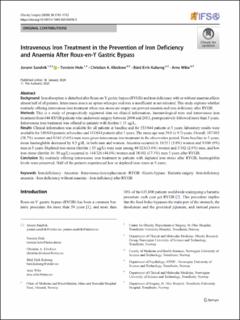| dc.contributor.author | Sandvik, Jorunn | |
| dc.contributor.author | Hole, Torstein | |
| dc.contributor.author | Kløckner, Christian | |
| dc.contributor.author | Kulseng, Bård Eirik | |
| dc.contributor.author | Wibe, Arne | |
| dc.date.accessioned | 2021-02-16T08:54:18Z | |
| dc.date.available | 2021-02-16T08:54:18Z | |
| dc.date.created | 2020-10-01T16:29:59Z | |
| dc.date.issued | 2020 | |
| dc.identifier.citation | Obesity Surgery. 2020, 30 (5), 1745-1752. | en_US |
| dc.identifier.issn | 0960-8923 | |
| dc.identifier.uri | https://hdl.handle.net/11250/2728251 | |
| dc.description.abstract | Background
Iron absorption is disturbed after Roux-en-Y gastric bypass (RYGB) and iron deficiency with or without anaemia affects almost half of all patients. Intravenous iron is an option when per oral iron is insufficient or not tolerated. This study explores whether routinely offering intravenous iron treatment when iron stores are empty can prevent anaemia and iron deficiency after RYGB.
Methods
This is a study of prospectively registered data on clinical information, haematological tests and intravenous iron treatment from 644 RYGB patients who underwent surgery between 2004 and 2013, postoperatively followed more than 5 years. Intravenous iron treatment was offered to patients with ferritin ≤ 15 μg/L.
Results
Clinical information was available for all patients at baseline and for 553/644 patients at 5 years; laboratory results were available for 540/644 patients at baseline and 411/644 patients after 5 years. The mean age was 39.8 (± 9.7) years. Overall, 187/483 (38.7%) women and 9/161 (5.6%) men were given intravenous iron treatment in the observation period. From baseline to 5 years, mean haemoglobin decreased by 0.3 g/dL in both men and women. Anaemia occurred in 18/311 (5.8%) women and 9/100 (9%) men at 5 years. Depleted iron stores (ferritin ≤ 15 μg/L) were seen among 44/323(13.6%) women and 3/102 (2.9%) men, and low iron stores (ferritin 16–50 μg/L) occurred in 144/326 (44.6%) women and 38/102 (37.3%) men 5 years after RYGB.
Conclusion
By routinely offering intravenous iron treatment to patients with depleted iron stores after RYGB, haemoglobin levels were preserved. Half of the patients experienced low or depleted iron stores at 5 years. | en_US |
| dc.language.iso | eng | en_US |
| dc.publisher | Springer Nature | en_US |
| dc.rights | Navngivelse 4.0 Internasjonal | * |
| dc.rights.uri | http://creativecommons.org/licenses/by/4.0/deed.no | * |
| dc.title | Intravenous Iron Treatment in the Prevention of Iron Deficiency and Anaemia After Roux-en-Y Gastric Bypass | en_US |
| dc.type | Peer reviewed | en_US |
| dc.type | Journal article | en_US |
| dc.description.version | publishedVersion | en_US |
| dc.source.pagenumber | 1745-1752 | en_US |
| dc.source.volume | 30 | en_US |
| dc.source.journal | Obesity Surgery | en_US |
| dc.source.issue | 5 | en_US |
| dc.identifier.doi | 10.1007/s11695-020-04396-5 | |
| dc.identifier.cristin | 1836369 | |
| dc.description.localcode | Open Access This article is licensed under a Creative Commons Attribution 4.0 International License, which permits use, sharing, adaptation, distribution and reproduction in any medium or format, as long as you give appropriate credit to the original author(s) and the source, provide a link to the Creative Commons licence, and indicate if changes were made. The images or other third party material in this article are included in the article's Creative Commons licence, unless indicated otherwise in a credit line to the material. If material is not included in the article's Creative Commons licence and your intended use is not permitted by statutory regulation or exceeds the permitted use, you will need to obtain permission directly from the copyright holder. To view a copy of this licence, visit http://creativecommons.org/licenses/by/4.0/. | en_US |
| cristin.ispublished | true | |
| cristin.fulltext | original | |
| cristin.qualitycode | 1 | |

